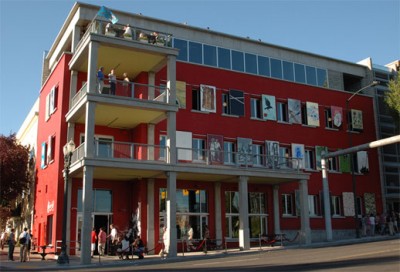Redefining what a creative building is

Would you live, work or play here? For many creatives, the answer would be yes, yes and yes. What makes Portland’s Burnside Rocket the kind of building they want to see more of?
On the outside…
1. It’s expressive, authentic and unique. It isn’t called the Rocket for nothing. From the red exterior to the art panel shutters representing 24 emerging local artists, you won’t find anything like it… in the world, really.
2. It’s human-scaled. Framed construction vs high-rise concrete. People don’t seem out of place standing next to it (or on top of it).
3. It features public spaces. These are the spaces that make a building come alive. There’s outdoor cafe seating on the ground floor and fourth floor, plus balconies large enough for a small party.
4. It’s car free. There’s no on-site parking, a sign of things to come, and a tremendous financial benefit. Spaces are shared with other buildings and mass transit is easily accessible.
On the inside…
1. It has progressive tenants. The building hosts a popular ground floor restaurant lounge and fourth floor restaurant, with open plan loft-style offices on the second and third floors.
2. It’s green. It’s LEED certified, with ground source heat pumps that eliminate the need for air conditioning with energy efficiency 40% beyond code, a rooftop garden used by the restaurant, and a well that provides all the water.
3. It’s affordable. Materials and construction are kept simple, passing the savings on to the tenants. Still, it’s designed to last at least 300 years.
The best part is that the developer, Kevin Cavenaugh, is looking to build more of these types of buildings, even consult those that want to develop such places in their own neighborhoods.

I love it! This This is the type of building that cities should be encouraging, either through adaptive use or small-scale infill.
It’s a nice building and idea. I especially love the art shutters. I disagree with part of statement number 2 (outside) “…It looks like it could have been built by hand without any heavy machinery”. Why is that an issue? That’s what it takes to get construction projects done. We don’t need to revert back to some renaissance style building method in order to be more creative. Let’s not get carried away.
Thanks Sugi, regarding #2, it was just a more artful way of describing frame vs concrete construction, whereas the former is generally 4-6 stories, and the latter 8-20 stories, thus requiring ‘heavy machinery’. Creatives tend to favor the 4-6 story height range, which I don’t think coincidentally, is more within the range of heights that can be built by, well, humans rather than requiring machines. For example, creatives value authenticity, and authenticity is described in the new book of the same name as that which is not man-made, or less perceived to be man-made.